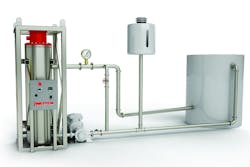What do the following things have in common: flatware for eating, decorative fixtures for the home and engine components that drive high-performance cars? All of them have distinctly different uses, designs, prices and reasons for purchase, but none of them could have been produced without process heating.
Process heating provides heat that aids in the production of everyday commodities and basic materials. It is used in the manufacturing of cement, steel, composites, cosmetics, textiles, computer chips
and electronics.
According to the U.S. Department of Energy (DOE), process heating is responsible for the employment of nearly 16 million people, and its use directly or indirectly earns an estimated $3.8 trillion annually for approximately 300,000 establishments across the U.S. Overall, it accounts for 36 percent of the total energy consumption in the manufacturing sector alone.
Its efficiency accounts for its popularity and use in a wide variety of industries. Determining which heating process to use is one of the most challenging decisions for manufacturing and industrial managers to make. Variables to be considered include the intermittency of the resource, the cost of the heating application, storage options and process integration.
How it works
Geothermal, solar and biomass sources make up the renewable heating segment of process heating. They can be used in a variety of industrial applications similar to traditional process heating. Commonly, geothermal, biomass and solar sources of heat can be used for air heating or water heating.
Industrial processes have different requirements for industries and products. Temperatures in
industrial heating can range from 212 to 750°F, and more than half of the industrial heating requirements can be accommodated to by heat levels less than 750°F.
For processes that require heat of more than 750°F, process heating is often accompanied by renewable heating resources that provide the pre-heating for the process heating to build on.
System components
Process heating systems are made up of four components that include:
- Devices for moving heat from the source it originates to its product
- Devices for generating and supplying heat
- Devices for the recovery of heat
- Devices for containing heat such as heaters, furnaces, kilns and ovens
In addition to these four systems, process heating requires a number of other support systems. These can be controls, sensors, process atmosphere and material handling. Other systems that are part of the process heating systems include safety systems, emission controls and a host of auxiliary systems. Together they take part in four basic heating methods: steam; electric; fuel fired; and air and water/oil.
Industry use
The use of process heating continues to remain at an all-time high due to its cost benefits, effectiveness and use of existing resources.
With the passage of time, however, innovative process heating uses have been developed. Renewable methods and more efficient process heaters work to ensure that process heating can improve on heat loss, which is one of the most important environmental issues over the last decade.
Industries that use process heating
Industrial processes that use process heating as either a primary, secondary, tertiary or subsidiary step include:
- Steel production
- Automotive parts production
- Gypsum production
- Glass production
- Appliances production
- Foundry production
- Basic chemicals production
- Specialty steels production
- Paint production
- Ores and minerals production
- Food production
- Computer chip production
- Copper and brass production
- Ship building production
- Jewelry production
- Ceramic production
- Textile production
- Defense equipment production
- Petroleum production
- Pipe and tube production
- Beverage production
- Paper production
- Fasteners production
- Carbon and graphite production
- Aluminum production
- Machinery production
- Asphalt paving production
- Composite materials production
- Plastics production
- Forging production
- Cement production
- Tools production
- Cosmetic production
- Precious metal production
- Powdered metals production
- Electronics production
- Weapons and armaments production
- Construction materials production
- Farm and heavy equipment production
- Aerospace components production
Ilan Toledano is the vice president of Wattco, a manufacturer of electric heating elements and controls for over 50 years. With more than 25 years of experience in the electric heating industry, Toledano has been involved in sales and marketing, product development, and expansion of the industrial immersion heaters in the water, chemical, and oil and gas industries.
